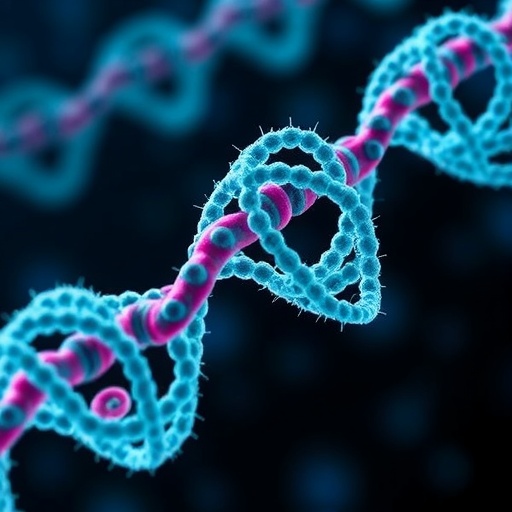
A revolutionary study published recently in Nature unveils the hidden dynamics of genome doubling in ovarian cancer, unraveling how this dramatic genetic event fuels tumor evolution by accelerating chromosomal instability. The findings offer unprecedented insights into the mechanisms through which whole genome doubling (WGD) reshapes cancer cell populations, ultimately influencing tumor progression and immune interactions.
At the heart of this research lies the use of single-cell whole-genome sequencing (scWGS) phylogenies—a cutting-edge approach that provides an unprecedented resolution of the cancer genome’s architecture and its evolutionary trajectory. By dissecting the chronological sequence of chromosomal copy number alterations (CNAs), scientists categorized these genetic events relative to the genome doubling timeline, distinguishing pre-WGD losses and gains from those occurring after WGD. This stratification illuminated distinct mutational landscapes tied to genome doubling status and tumor clonality.
Intriguingly, ancestral gains of whole chromosomes or chromosome arms—often considered key routes for oncogenic progression—were generally scarce across the cohort. However, their incidence was notably elevated following WGD events compared to pre-WGD stages. This suggests that genome doubling might prime the genome for subsequent chromosome gains, marking a shift in the tumor’s evolutionary potential.
.adsslot_EaGFmCj6Ul{width:728px !important;height:90px !important;}
@media(max-width:1199px){ .adsslot_EaGFmCj6Ul{width:468px !important;height:60px !important;}
}
@media(max-width:767px){ .adsslot_EaGFmCj6Ul{width:320px !important;height:50px !important;}
}
ADVERTISEMENT
Conversely, chromosomal losses outnumbered gains by nearly an order of magnitude in every examined context, underscoring the pivotal role of deletions during tumor evolution. The predominance of losses, especially post-WGD, paints a picture of a genome shaped by contraction and pruning as much as by expansion—a nuance that challenges prior assumptions focusing heavily on amplifications in cancer genomes.
Further analysis revealed that the ratio of chromosomal losses to gains was significantly higher on ancestral branches relative to cell-specific events, implying that early tumor evolution is characterized by widespread loss events embedding a deeply altered genomic foundation. Simulation experiments reinforced the idea that the pseudo-triploid karyotypes observed in high-grade serous ovarian carcinoma (HGSOC) cannot simply arise through incremental gains atop a diploid background. Instead, this aberrant ploidy likely stems from an initial WGD followed by progressive losses occurring both before and after the doubling event, highlighting the complex choreography of chromosomal instability driving tumor diversity.
Delving deeper, the study compared representational differences between truncal (early, clonal) and subclonal WGD clones. Results showed that truncal WGD clones harbor considerably more chromosomal alterations than their subclonal counterparts, including about three times as many arm and whole chromosome losses. This finding suggests that clones which achieve early genome doubling and accumulate losses over time are selectively advantaged, fostering expansion within the tumor microenvironment.
Notably, some subclonal WGD clones exhibited surprisingly few post-WGD alterations, occasionally mirroring the mutation counts of divergent cell lineages rather than fully progressing clones. This plasticity casts light on the heterogeneity of tumor evolution where certain subclonal populations may undergo WGD without immediately embarking on extensive chromosomal remodeling, reflecting alternative evolutionary pathways or fitness landscapes.
Moreover, the abundance of chromosomal losses within truncal WGD clones showed a significant correlation with the age of the WGD event, as measured by the accumulation of characteristic C>T CpG mutations during the course between genome doubling and sample collection. This molecular clock-like behavior substantiates a model in which post-WGD chromosomal losses accumulate gradually over time rather than occurring as a burst of immediate instability.
Collectively, these observations support a fitness-driven evolutionary scenario where genome doubling acts as a catalyst for increased adaptability. Cells that withstand the initial upheaval of WGD and subsequently accumulate losses in a controlled manner are more likely to thrive. This mechanism underscores the evolutionary advantage conferred by genome doubling in fostering long-term tumor growth and complexity.
What emerges from this research is a nuanced view of genome doubling not merely as a one-time event but as an ongoing process sculpting the cancer genome. It orchestrates a delicate balance between chromosomal gains that enhance gene dosage and losses that may eliminate deleterious or unnecessary genetic material, dynamically tuning the cancer cell’s genome for survival and expansion.
This intricate genomic remodeling has profound implications for understanding the progression of ovarian cancer, as the interplay between WGD and chromosomal instability shapes not only tumor heterogeneity but also responses to therapeutic interventions and immune evasion mechanisms.
By tracing the evolutionary footprints of genome doubling and its aftermath, this study paves the way for novel therapeutic strategies targeting the vulnerabilities created by WGD-driven instability. It encourages the development of interventions designed to disrupt the adaptive landscape that WGD enables, potentially curbing tumor progression and metastasis.
The work also highlights the power of single-cell sequencing technologies coupled with sophisticated phylogenetic analyses in decoding cancer evolution at an unprecedented scale, setting a promising precedent for future investigations into the genetic and epigenetic complexity of malignancies.
As genome doubling emerges as a fundamental force in shaping tumor biology, ongoing research will need to consider how these genomic upheavals intersect with cellular processes such as DNA repair, replication stress, and immune dynamics—opening new frontiers in cancer science and precision medicine.
In summary, this landmark study not only clarifies the role of genome doubling in ovarian cancer evolution but also redefines our understanding of chromosomal instability and its contributions to cancer adaptability and resilience. The insights gained here will reverberate through the fields of cancer biology, genomics, and translational therapeutics for years to come.
Subject of Research: Ovarian cancer evolution, chromosomal instability, and whole genome doubling dynamics analyzed via single-cell whole-genome sequencing.
Article Title: Ongoing genome doubling shapes evolvability and immunity in ovarian cancer.
Article References:
McPherson, A., Vázquez-García, I., Myers, M.A. et al. Ongoing genome doubling shapes evolvability and immunity in ovarian cancer. Nature (2025). https://doi.org/10.1038/s41586-025-09240-3
Image Credits: AI Generated
Tags: cancer genome architecture analysiscancer research and phylogeneticschromosomal copy number alterationschromosomal instability in cancerevolutionary dynamics in tumorsgenome doubling in ovarian cancerimmune interactions in ovarian cancermutational landscapes and genome doublingoncogenic progression and genome doublingsingle-cell whole-genome sequencingtumor clonality and genetic eventswhole genome doubling and tumor evolution
